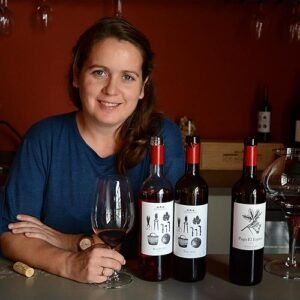It’s not easy to think about, but on the ‘top shelf’ of the sunny and scorching Costa del Sol lies one of Spain’s most innovative wine regions – Ronda.
Ronda highlands, rain and shine
Ronda is just a few tens of kilometers from the Costa del Sol, but almost a kilometer higher which completely changes the climate. In Ronda, temperature variations of up to 20 degrees Celsius per day are common, even during the growing season. In the highlands, Atlantic and Mediterranean winds blow alternately, so after foggy mornings the vines dry out quickly. It also rains quite a lot in Ronda, 800 ml per year, so there is plenty of water available. The Ronda soil is mainly clay and limestone, which also has a high moisture retention capacity. The vines have enough water even in the rather dry summer months. Even so, growers are installing irrigation systems on new plots. It’s good insurance against a warming climate, they say.
Clearing the table about the Ronda wine region
Wine has been grown in Ronda since Roman times, but phylloxera put a stop to it here too in the mid-1800s. In fact, the pest was the first to spread to Ronda in Spain, via the international port of Malaga.
The German Federico Schatz can be considered the pioneer of Ronda’s new heyday. Schatz began making the first experimental vintages as early as 1982 and from there, as the 90′ onwards, the charm of Ronda as a wine region began to interest winemakers who wanted to do something different from the rest of Spain.
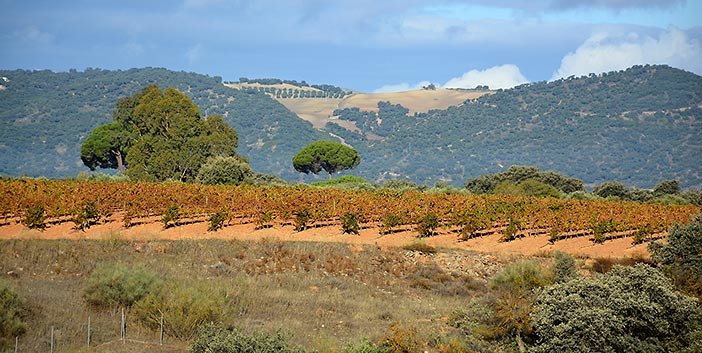
Today, Ronda is certainly one of the most interesting wine regions in all of Spain. It is not a “Gran Reserva” that is stuck in a rut, growing on a plate, but a wine-making area characterized by innovation and a burning desire on the part of young winemakers to create something new and updated, without compromising on quality – quite the opposite, in fact. In Ronda in general, the grapes are hand-picked, no sugars or acids are added and sulfites are kept to a minimum. There are few organic certifications, but the methods are already in use by many.
Ronda’s wines are often very pure, fresh and authentic. You could say that Ronda has been given a fresh start from a clean slate. Such an opportunity does not come too often in the highly regulated European wine industry.
Cortijo Los Aguilares double gold
Five kilometres east of the town of Ronda, at an altitude of 900 meters, the Los Aquilares estate enjoys the cool microclimate of the Sierra de la Nieves. Conditions for farming have been favorable for a couple of thousand years. Evidence of this can be seen in a Roman-built granary next to the current main building.
The 800 hectare farm still produces cereals, olives, free-growing iberico sauerkraut and, since 1999, wine from 20 hectares.
BODEGA CORTIJO LOS AGUILARES . RONDA, MALAGA, ANDALUCIA (FILM-EN) from Cortijo Los Aguilares Ronda on Vimeo.
Bibi Garcia is on her way to becoming an icon of Ronda wines
Young female Enologist Bibi Garcia stepped into the Los Aguilares story in 2007. Bibi has previously worked in Chile, Rioja and Priorat, where wine is also made in the mountains, but where the philosophy of wine-making is very different.
Where Rioja is locked into Tempranillo and Priorat Garnacha, D.O Málaga based D.O. Sierras de Málaga, a young appellation of origin founded in 2001, is very flexible in terms of quality standards for its mild wines. It gives Bibi the latitude required of a visionary with grape varieties, for example. Indeed, Los Aguilares has a fine selection of international grapes; Pinot Noir, Tempranillo, Merlot, Cabernet Sauvignon and Petit Verdot.
In Ronda, Bibi uses organic methods in viticulture, although there is no certification yet. ” No customer has required it so far, so we haven’t gone into a paper war,” she says.
The use of sulphites is also kept to a minimum. At harvest time, the picking gloves (yes, everything is hand-picked) are put on at 12 noon, when daytime temperatures start to rise and the grapes no longer stay cold, increasing the risk of oxidation. When the grapes arrive in the cellar, they go into the cold room to wait to be put on the belt. This ensures that the grapes remain fresh until the last moment before sorting. It is also important for Bibi that the grapes are lifted into the fermentation tank by belt and not by pump, so that the skins do not break down too early.
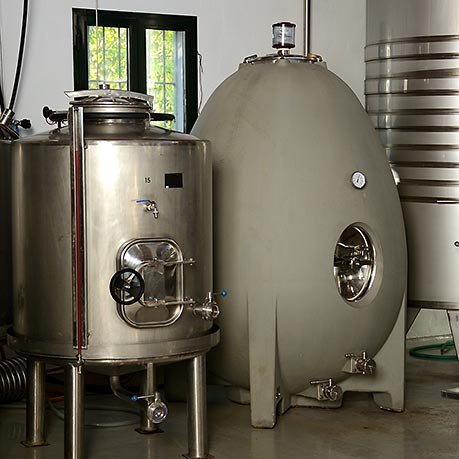
I can well imagine how difficult it must have been as a young winemaker to justify these absolute and expensive methods to the farm’s treasurer, when Bibi stepped in. But now the proof is in and he is calling the shots. Bibi Garcia’s singularly determined ingenuity won Los Aguilares Pinot Noir 2008 vintage gold at the extremely prestigious Swiss Mondial du Pinot Noir 2009. It was a stunt that shook the entire wine world. What? Ronda? That would have gone a long way, but a couple of years later the trick was repeated in the same competition and now, at the very latest, the whole wine world is turning its attention to the tiny Ronda.
A bright future ahead?
A few kilometres up a bumpy track is Bibi Garcia’s own discovery, the five-hectare Pelele parcel. She fell in love with the soil on the patch, a red shale with a fair amount of granite. She commissioned soil specialists from as far away as Burgundy to visit the site, who found it to have great potential for wine production.
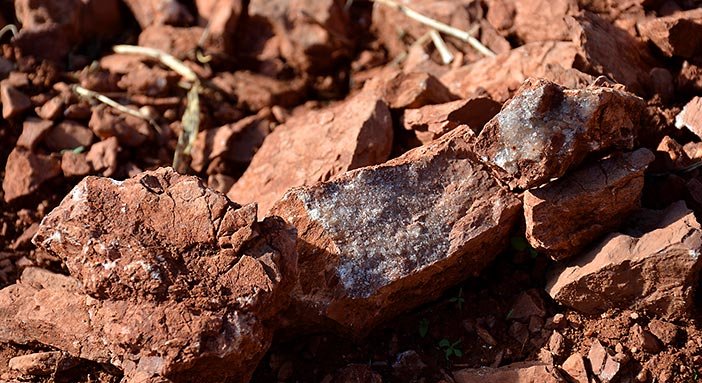
In May of this year, the first seedlings hit the ground, mainly Garnacha with four different hybrids represented. The aim is to have the first wines from Pelele worthy of the name on the shelves in 2019. It will be interesting to see what this visionary of Ronda and perhaps the star of Spain’s winemaking universe can do?
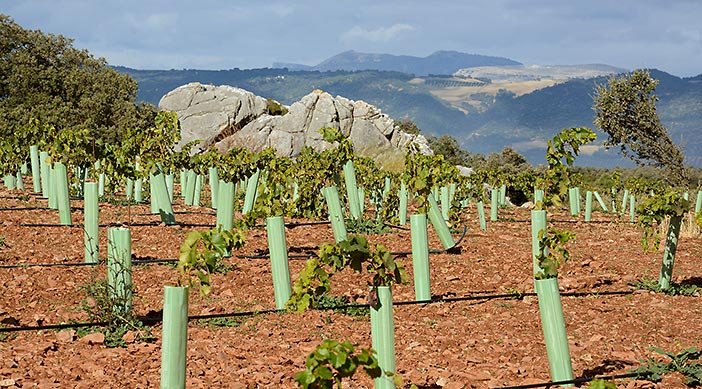
Cortijo Los Aguilares wine tasting
Unfortunately (but understandably), the estate’s flagship Pinot Noir and Tadeo, made from Petit Verdot, were so completely sold out that the journalist didn’t get a drop. The three other wines from the estate, however, showed that we were on the verge of something truly unique.
Rosado 2013
Scent of rose and redcurrant. Elegant rosé. Fresh on the palate, with great acidity, mineral and length. Top roses. Said to go with almost any food, but best with paella.
Trait 2013
Lush berry scent. Dark tones. Lively taste. Velvety and youthfully acidic. Nice tannins. A young wine, but a good wine and drinkable now.
Pago el Espino 2010
An interesting, slightly developed aroma. Exciting nutty oak. Balanced palate is full-bodied, fresh and long. Intense dark berry notes. Nice tannic finish. A clean and stunning wine.
www.cortijolosaguilares.com
La Melonera and historical wine varieties
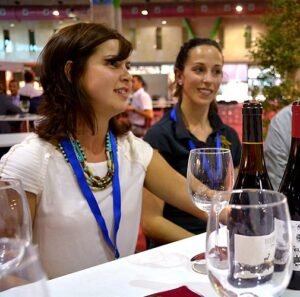
Also at La Melonera, there is faith in the young winemaker. A burning enthusiasm for winemaking, respectful of the old but bursting with new ideas, also reflects Ana de Castro‘s philosophy of wine. The estate grows not only the traditional Syrah, Garnacha and Cabernet Sauvignon but also ancient varieties such as Tintilla, Blasco, Romea and Melonera.
I came across Ana de Castro in May at the Malaga Food and Wine festival and this sparked a spark for Ronda wines myself. Unfortunately, during the trip to write this article, schedules didn’t meet, so the farm visit remained a dream. The tastings the other day were promising enough that La Melonera deserves a mention. Really crisp and with a poignantly interesting aroma, La Encina del Ingles is made from grapes such as M.Morisco, Doradilla and Pedro Ximenes (i.e. the very same grape used to make sweet sherry). The Payoya Negra 2011 had the lush berry aromas and restrained, spicy and elegantly tannic flavours typical of red wines from the Ronda region.
lamelonera.com

Descalzos Viejos – wine and frescoes

Flavio Salesi, born to an Italian family in Argentina, is a lively guy who is a mix of rock star, artist and businessman.15 years ago, before coming to Ronda and his winemaking life, he was an architect.
The main building of the winery is a monastery built in the 1500s, on the cliff face, which Flavio and his partner Paco Retamero bought in 1998 and restored to new splendor, including the roof frescoes and the courtyard garden. Flavio likes to show off the balcony overlooking the valley from the office space, and you have to admit the architect knows what he’s doing. No one else has a view like this from the office!?
The farm owns six acres and controls four acres. Varieties include; Cabernet Sauvignon, Syrah, Garnacha, Graciano, Petit Verdot, Merlot and Chardonnay. In addition to Spain, there are markets for their wines in Scandinavia, Belgium, Switzerland and even Taiwan. With the global interest in their wines, they have had no problems selling their production during the economic crisis, but despite this, Salesi is happy to look to the future.
– “We deliberately keep about 10% of the vintage in stock so that we don’t sell out of everything at once,” he says. “This allows us to keep our local regulars interested in our wines all the time, and helps them to remember us when the general economic situation in Spain improves.”

Flavio Salesi lists among the advantages of the Ronda wine region the efforts of small winery to produce top quality – something that has not counted in favor of D.O Malaga’s original classification before. Ronda’s winemakers are also like family, not competitors. And why compete? They are working towards a common mission; to put Ronda wines on the world map. There’s enough of that trophy for everyone.
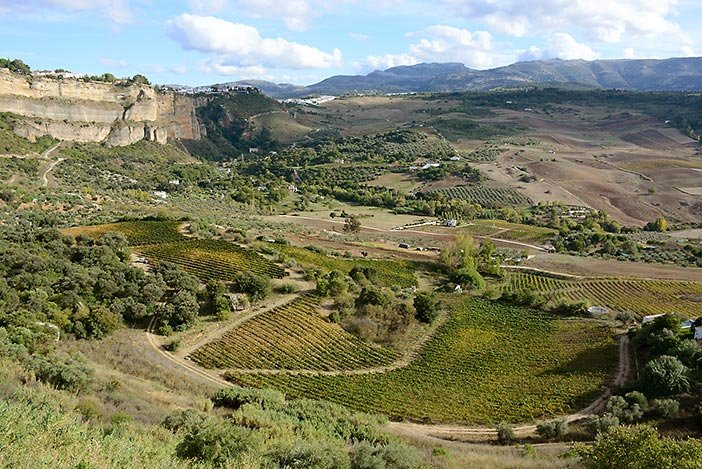
Descalzos Viejos enologist Vicente Inat is good friends with Bibi Garcia of Los Aguilares, and they exchange advice on cultivation without any talk of trade secrets. Sales’ fingers are already itching for a few more hectares to increase production, but in moderation. “We are artisans first and foremost, not winemakers,” he brakes, however. Buying land on this side of the Ronda gorge is not straightforward: ‘The paperwork and bureaucracy is absolutely insane,’ Flavio agonises: ‘You can imagine, this is a valley protected for the view, and nothing is changed without the permission of ten agencies. And that’s a very good thing, of course, because otherwise you’d have a golf course in the middle and a spa next to it,” he says, referring to the valley. “Look at the Costa Del Sol, we’re not that far away from that disaster!”
Descalzos Viejos wine tasting
Chardonnay
Cosy aromas. Ripe citrus. Apple. A hint of oak vanilla. Balanced and fairly fruity. Subtle acidity. Herbs at the end.
DV+ 2008
Mainly aromatic. Cherry jam. A touch of vanilla. Rich but velvety on the palate. Fresh acidity. Powerful. Slightly herbal. Great oak on the long finish. For red meat.
www.descalzosviejos.com
Text and photos: Janne Suomi
Last Updated on March 17, 2023 by Flavorado
This post is also available in:
Suomi


